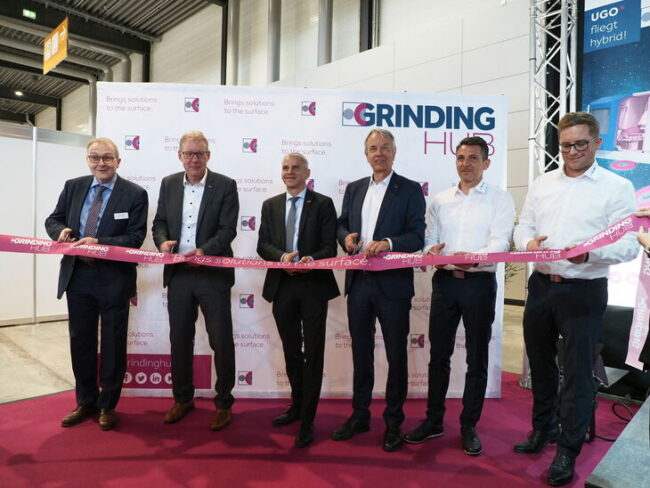
GrindingHub 2024 was officially opened on 14th May. The international trade fair for grinding technology is being held in Stuttgart for the second time. “This is the second GrindingHub, and the event has already established itself as the undisputed meeting place for the grinding technology community,” says a delighted Dr. Markus Heering, Executive Director of the VDW (German Machine Tool Builders’ Association), the organizer of the event.
Grinding technology is a small but thriving sector which represents one of the most important metalworking processes. “It is so gratifying to be able to bring together all the international market leaders and put together such an attractive show for trade visitors,” continues Heering.
The GrindingHub in figures: around 490 exhibitors from over 30 countries, more than half from abroad, roughly 41,500 gross square meters in four halls – up from the previous three. The range of products has also been expanded and now covers more than 40 product sectors. There is therefore growth in all the key figures. “And this means that we are meeting in full our aim of showcasing the entire grinding process chain,” explains Markus Heering.
Dr. Patrick Rapp, State Secretary in the Baden-Württemberg Ministry of Economic Affairs, Labor and Tourism, was also present at the opening. He had previously taken a tour of the trade fair and visited the stands of various exhibitors from Baden-Württemberg. “As a sub-section of the machine tool industry, grinding is a key technology that enables precision parts and components to be manufactured that can then be used in high-tech products. I am greatly impressed by the broad range of new developments on show here which help speed up and simplify important production processes,” he adds.
GrindingHub has the power to boost investment
In its role as both a supplier and a customer, Germany plays in the premier league of the grinding technology sector. Last year, it posted strong results, including production valued at EUR 1.1 billion and growth of 14 percent here in Germany. Consumption grew by a similar amount, rising by 10 percent. Exports and imports both performed well, up 15 percent and 11 percent respectively.
Last year’s strong results, however, put the current figures in the shade by contrast. Orders have been declining since the beginning of 2023. At the end of 2023, there were a fifth fewer orders on the books than a year earlier. This decline continued in the first quarter of 2024. The first glimmers of hope, however, are beginning to shine through for the machine tool industry. Manufacturers’ expectations jumped significantly in March. These are the very first signs of a potential stabilization in the coming months. Another positive sign is coming from the second most important customer, the engineering sector. Last week, the VDMA reported that the slump in foreign demand was bottoming out and that there was evidence of a sideways movement in Germany.
“These developments need to be welcomed and supported. And the GrindingHub can make a significant contribution here. The innovations presented at the event have the potential to boost investment, as many of them help raise users’ efficiency levels,” says Heering.
Björn Köbler and Armin Ranzenberger, both managing directors at Köbler Zerspan- und Rundschleiftechnik GmbH from Weißenburg in Bavaria, take a similar view. The family business has around 30 employees and produces high-precision parts for the special engineering, medical technology, aerospace and other industries that demand the highest level of quality. It is constantly investing in new technologies to help it meet these requirements. Köbler has recently expanded its machine park by 15 percent. “For us, the main focus is on automation, machine learning and artificial intelligence (AI). These help relieve the strain on employees but also speed up production and make it less error-prone,” both of them report. The GrindingHub is the perfect place to get pick up new ideas.
High-level expertise for the future of grinding technology
In addition to the extensive range on display on the exhibitors’ own stands, the supporting program represents a further source of ideas and inspiration. The program includes the GrindingSolution Park Science on stand D20 in Hall 10. Five institutes are presenting their latest research projects in the field of grinding technology. The aim of the GrindingSolution Park Science is to help them make the leap from the laboratory to industrial practice. The research topics include networking, new materials, process reliability, machine learning, sustainable production, digital process integration and innovative tool concepts for precision surface finishing.
The umati (universal machine technology interface) stand (D20) in Hall 9 is the central point of contact for visitors seeking information on the use of OPC UA in grinding technology. More than 50 specifications are currently being drawn up in the fields of mechanical and plant engineering with the aim of ensuring seamless communication in the factory on the basis of OPC UA. Ten or so sectors have contributed their specifications to the umati initiative. Around 360 international partners – machine manufacturers, research institutes and industry associations – are collaborating to prove that communication based on open, independent standards is a successful model.
The Start-up Hub on stand D 50 in Hall 7 will also be showcasing plenty of innovations. The offerings of the young companies are striking. They include new machine concepts, software for automated procurement, innovative diamond coatings for cutting tools and wear parts, AI-based maintenance software and high-precision cutting edge preparation for cutting tools. Such preparation can have a decisive influence on the precision, flexibility and cost-effectiveness of a tool.




COMMENTS